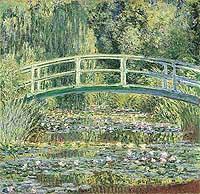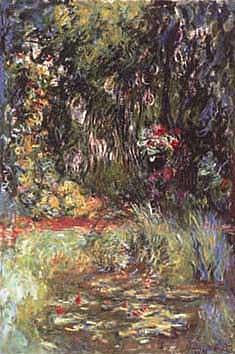|
Amit
Varma - CLAUDE
MONET'S WATERLILIES
| Claude
Oscar Monet was born on November 14th, 1840 in Paris,
France but grew up and studied drawing and art in Le Havre. At
the age of 19, he had committed himself to becoming an artist
and spent more and more time in Paris. From the beginning, Monet's
style had been unconventional and later became famous for his
transient effects of natural light and his sketch-like application
of bright colors on the canvas. In 1862, Monet entered the studio
of Charles
Gleyre in Paris where he first made acquaintance with Renoir,
Sisley,
and Bazille,
with whom he was to form the nucleus of the next great art movement.
Later, in an attempt to appeal directly to the public, Monet and
some of his colleagues organized an exhibition and called themselves
the "independents",but because of the nature of their
paintings looking ˜unfinished and sketchy" their group became
known as the "impressionists" since their paintings looked like
a first impression and since one of Monet's painting had the title
Impression:
Sunrise. |
 The Waterlily Pond, 1900
oil on canvas, 89 x 92 cm.
The Waterlily Pond, 1900
oil on canvas, 89 x 92 cm. |
During
the next twenty years, Monet would perfect his signature distinct
strokes, loosely structured paintings, which gave the viewer a
spontaneous impression of nature. Monet even made trips to the
coasts of France in order to study the brilliant effects of light
and color to incorporate them more accurately for a more refined
expression in his paintings. In 1890, Monet bought some property
in the village of Giverny near Paris and constructed a water garden,
a lily pond arched with a Japanese bridge and overhung with willows
and clumps of bamboo. From this point forward, Monet's paintings
mostly consisted of this pond and water lilies. |
| Claude
Monet, a father of the impressionist art movement, has influenced
many other painters of the 20th century and his Water
lilies paintings have especially impacted abstract paintings of
the century. Monet's philosophy for painting has been to "forget
what objects you have before you--a tree, a house, a field, or
whatever. Merely think, here is a little square of blue, here
an oblong of pink, here a streak of yellow, and paint it just
as it looks to you, the exact color and shape..." This idea
of shapes and colors representing a figure without actually drawing
the figure is what has made the principal behind abstract painting.
It allows for each individual viewer to see something different
in the painting. Without something definitive or concrete in the
painting, the viewer is forced to manipulate the colors and shapes
and arguably Monet and the impressionists lead the way for abstract
painters from the latter 20th century. Monet once said
"I wished I had been born blind and then had suddenly gained
my sight so that I could have begun to paint in this way without
first knowing what the objects were that I saw before me...."
To the eye, there are only masses of color and shape, and inconstant
colors and shapes at that, changing as the light changes, changing
as our angle of vision changes: this is what made Monet's water
lilies a gateway for abstract artwork. |
 Waterlily Pond, 1918
Waterlily Pond, 1918 |
Monet
has long been an advocate of abandoning the studio and painting
on the spot ”sur
le motif” and was brilliantly successful in achieving
the impression of a fresh view of nature, in creating on his canvas
the spontaneous and transient light and color of the moment. The
main similarity between the abstract painting of the 20th
century and the impressionist paintings is that the impression
on the viewer's eye, the visual sensation, is what guides the
artists' brush and what evokes the emotion in the viewer. In my
opinion, what makes the Water lilies so beautiful is the fact
that the thickness of the paint in certain areas, along with the
changing color tones allows for many paintings to lie inside just
one painting. Different angles and different lighting all affects
the painting in a certain way. Monet's paintings seem to instill
powerful imagery that a viewer feels a mystical or spiritual tranquility
when viewing his water lilies. In this similar way, abstract painting
also creates a mystical feeling where each viewer manipulates
the shapes and colors in their own way making the painting rather
unique for each. |
|
|
WORKS CITED
http://www.bc.edu/bc_org/avp/cas/fnart/art/monet.html
http://www.seven7.demon.co.uk/monet/history.htm
|
|